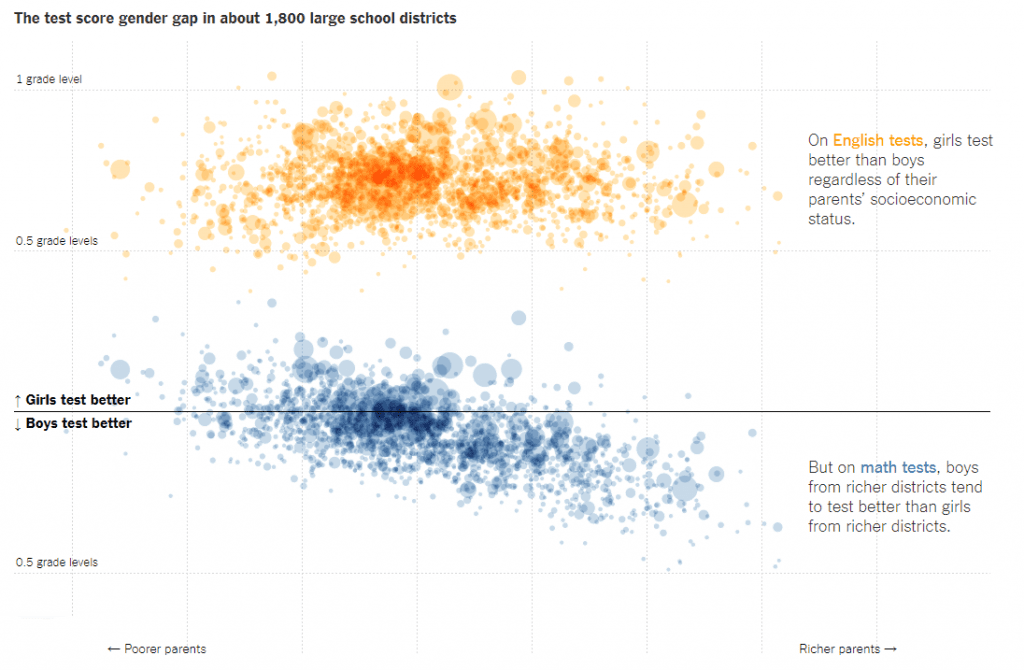
Ann Althouse regularly observes that if a data item tends to show men better off or better at something in some area or another, it’s taken as a sure sign of sexism. If, on the other hand, women are revealed to be better at something, it’s a sign of women’s innate superiority.
Witness a September article from the New York Times that I happened to stumble upon: “Where Boys Outperform Girls in Math: Rich, White and Suburban Districts“; the key item in this article is a graphic, which is reproduced at Coyote Blog:

The upshot of the data visualized in this manner is that, up through eighth grade, girls perform better than boys on English tests regardless of their socioeconomic status but that, on average, boys and girls score the same at math tests, though this masks gender gaps swinging in different directions depending on whether the children attended richer or poorer schools.
If one takes it as a given that, as seems to be borne out by longtime understanding of relative skills of each sex, girls are better at verbal skills and boys better at the sort of skills that underlie math skills, then this shows that boys in poor families and poor areas are in serious trouble. And the Times recognizes this, to a certain degree, writing,
Black and Latino boys and those in poor neighborhoods often get the message that doing well in school is not manly, a variety of research has found.
But the article still misses the point when it focuses on girls’ academic success as normal, but elements in which boys do better as something for which blame must be assigned and which must be overcome:
Although well-off districts encourage boys in math, they don’t seem to encourage girls in the same way. Researchers say it probably has to do with deeply ingrained stereotypes that boys are better at math.
Teachers often underestimate girls’ math abilities, according to research by Sarah Lubienski of Indiana University and Joseph Cimpian of New York University, who also found the gender gap in math was largest for students from high-income families. They found that as girls move through elementary school, they lose confidence in their math skills – more than they lose interest or achievement.
And in the meantime, 56% of college students are female, as are 57% of new college graduates.
Oh, and in the meantime, Boy Scouts of America invited girls to join its primary program, no longer “Boy Scouts” but merely “Scouts,” in sex-specific troops, and the Girl Scouts has now sued them claiming that they have the exclusive rights to the name “Scouts” in connection to girls (incidentally, this is something that was not an issue in other English-speaking countries when the boys’ organization invited girls in because the girls’ organization had always called themselves “Girl Guides”). But the differences between the GSUSA and the BSA’s offerings for children is striking, as the Boy Scouts, or Scouts, or “BSA,” continues its emphasis on character development, leadership, and the outdoors and the Girl Scouts promotes Girlpower!, for instance, with a new push for STEM programs to increase girls’ interest in, and eventually women’s representation in, STEM fields, as described in Friday’s Trib (with an emphasis on promoting jobs “outside of stereotypical science roles”/outside of laboratories, though it’s not entirely clear what that meant, that is, if it was simply meant as a wide-ranging introduction to careers or they had something else in mind; some time ago, in a blog post I can no longer find, I wrote that girls are being told that they can be scientists without being nerds in an implicit rebuke of boys as nerds).
So, again, society is throwing all manner of resources into girls’ success, then lamenting that young men are increasingly failing to succeed in life.
Image: https://www.flickr.com/photos/wwworks/15344079560












